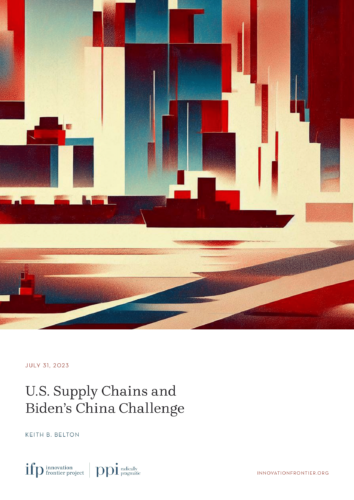FACT: National Security Council — Trade policy not “at the core” of “international economic policy.”
THE NUMBERS: U.S. economy 2022
GDP: $25.5 trillion
Of which, exports: $3.0 trillion*
Manufacturing: $1.6 trillion
Digitally deliverable services $720 billion
Energy $380 billion
Agriculture $196 billion
*Census for goods trade, BEA for digitally deliverable services. Definitions of “manufactured goods,” “energy,” and “agriculture” overlap; figures above include NAICS for manufacturing, USDA for agriculture, and HTS-27 for energy. BEA’s “ICT” and “potentially ICT-enabled” services include computer and telecommunication services, intellectual property revenue, finance, and insurance, “cultural and recreational” services such as entertainment and media, business & professional services such as architecture, accounting, advertising, research & development, etc.
WHAT THEY MEAN:
A late-June comment from the National Security Council’s “International Economics” Deputy: Asked at a Carnegie Endowment event what “compelling practical value proposition” the U.S. has to offer developing countries on trade, the NSC officer tells them they should be thinking about something else. Our transcription:
“[W]e’re at a place where average U.S. tariffs are at historic lows, still 2.4% … in a lot of ways we don’t see tariffs as being at the core of trade policy, and we don’t see trade policy as being at the core of international economic policy. What needs to be at the core of international economic policy? Well, an emerging set of challenges that haven’t been addressed — things like supply chain fragility and resilience, things like climate and clean energy, things like anti-corruption, things like global tax. Those are the kind of pressing economic issues internationally right now.”
Japanese Prime Minister Kishida, speaking across the street at Johns Hopkins/SAIS a few months earlier during his January visit, sees a quite different “core.” His counterpoint:
“[T]he core of what creates an economic order in the region [i.e., Asia-Pacific] is a framework with market access for goods and services. In the Asia-Pacific region, we indeed have such a framework, the Trans-Pacific Partnership. The TPP was originally initiated by the United States, and then was eventually launched without U.S. participation. Now, the United Kingdom, China, Taiwan, and others have expressed their intention to join this agreement. Against the backdrop, let me state that the United States’ return is of paramount importance.”
A couple of cautions before over-interpreting anything: While context suggests that the NSC Deputy is making a general statement about the non-“coreness” of trade policy, he is responding to a question specifically about economic relationships with developing countries and perhaps meant something less sweeping. Likewise, it isn’t exactly clear who his “we” includes (the NSC staff as a group?), as policy statements by administration Cabinet departments, by neighboring EOP “components” with economic or trade authority such as the Council of Economic Advisers and the U.S. Trade Representative Office, and by independent agencies like the Ex-Im Bank, et al, don’t typically reach such a Lao Tzu-like plane of inertness. But these cautions noted, two observations:
1. Foreigners looking at the U.S.: As we noted last month, NSC’s “2.4%” average tariff rate isn’t factually correct and (more important) wouldn’t be very relevant if it were. In general, tariffs as taxation of imported goods are one component of a larger “market access” concept — that is, the policy-induced cost and ease or difficulty of selling something to a foreign customer — which also includes quota limits, import licenses, some types of regulatory approvals and services policies, customs efficiency, and so on. Foreigners often have good reason to view this set of issues as important, and American policymakers can’t easily disentangle them from ‘core’ issues such as supply-chain fragility and resilience. As a mini-case study, the ‘average’ U.S. tariff rate on imports from New Zealand was 2022 was a modest 1.0%, but Kiwis are more concerned about restrictive dairy quotas and illogical inspection rules. These, together with tariffs of 17.5% (under quota) and “13.6% + $1.035/kg” (above quota), make it nearly impossible for American grocery stores to buy New Zealand infant formula. This in turn the main reason the U.S. “supply chain” for formula is fragile, non-“resilient,” and prone to shortages and hardships for moms when one of the dozen or so U.S. formula plants runs into trouble.
With respect to tariffs as such, few countries see a “2.4%” average. U.S. tariff rates vary by product (as do those of other countries), from mostly zero or near zero for energy and natural resources, to low to medium for industrial inputs, and high for lots of consumer goods. Thus by country, rates run in a continuum from near-zero for resource exporters (say, Saudi Arabia, Greenland, Kazakhstan) and countries exempted from tariffs through free trade agreements or “preference” programs, to an 8%-15% range for low-income Asian countries specialized in clothing (Cambodia, Pakistan, Bangladesh, Sri Lanka). So foreigners often have reason to view “market access” generally, and sometimes tariffs specifically, as important or even “core.”
2. Americans looking outward: The same applies in the other direction. NSC’s interest in anti-corruption and global tax issues isn’t trivial; neither, however, are more local questions about American job quality, growth sources, and inflation-fighting. For example, the United States has its own large but troubled export sector, measured at $3 trillion last year. Among much else this sector provides 20% of American farm income; creates markets for $1.6 trillion in U.S.-produced airplanes, cars, semiconductor chips, MRI machines, and other manufactured goods abroad; sends $720 billion in digitally deliverable services abroad via wire and satellite beam; makes up a ninth of Oregon’s GDP and a fifth of Texas’; supports 21,000 women-owned exporting businesses with over a million employees; and, in macro terms, presents ways to help the U.S. sustain growth as government fiscal stimulus fades and Federal Reserve interest rates cool off U.S. demand.
The export sector has lots of headaches though, and it could use policy help. To draw a few from various government sources:
-
-
-
- Gloomy statistical trends: The Census Bureau’s tally of exporting U.S. firms has dropped by about 12%, from a peak of 305,000 late in the Obama administration to 278,000 as of 2022. Meanwhile, the U.S. share of world exports has dropped by WTO count from 9.1% to 8.3% in goods, and 15.2% to 12.8% in services.
- Policy problems not rare: The 2023 edition of the U.S. Trade Representative Office’s 467-page “National Trade Estimate Report on Foreign Trade Barriers” recounts objectionable policies whose revision might help a bit, ranging from mandatory Tunisian “import license” rules for automobiles, through Nigerian bans of American chicken and beef, to an Indian “simple average” tariff rate of 18.3%, seven pages of European Union ag policies, Chinese subsidies, and lots more.
- Foreign tariff and “market access” arrangements: Few foreign governments share the view that trade is not a core part of international economic policy. As they continue reducing barriers to one another’s products via the “Regional Comprehensive Economic Partnership,” the CPTPP Prime Minister Kishida cites, European and Chinese agreements with South American countries, etc., the policy landscape is tilting against American businesses and their workers.
Against this background, P.M. Kishida looks tactful and correct as he gives his own view of what might be at the “core” of international economic policy. The NSC’s approach, whether in terms of international economic order or more local concerns about jobs, inflation, and growth, looks very much in need of its own rethink.

FURTHER READING
NSC’s Deputy at the Carnegie Endowment: The eight-minute exchange on the U.S.’ “practical value proposition” for developing countries, the non-core status of trade policy, etc., begins with a question at about 09:00, with the quoted passage at 16:00.
Six months earlier and across Massachusetts Avenue at SAIS, Prime Minister Kishida’s view of U.S.-Japan relations, Asia-Pacific security, market access, and economic order.
Case study:
Kadee Russ (UC-Davis) and Phillip Dean (Deakin University, in Australia), look at infant formula tariffs, quotas, trade, and shortages.
Elsewhere in the administration, some different emphases:
The Department of Agriculture reports a record $196 billion in farm exports for 2022.
The U.S. Trade Representative Office’s National Trade Estimate Report on Foreign Trade Barriers 2023 spans 467 pages of foreign tariffs, import licenses, objectionable agricultural policies, digital trade barriers, subsidies, and more.
Ex-Im Bank Chair Reta Lewis and the Congressional Black Caucus confer last June on export opportunities for minority-owned businesses.
And the Commerce Department’s blog-site has export promotion goals for 2023.
Dome data:
Census’ main trade data page.
Census and BEA on ownership, pay, markets, and employment for exporting companies.
USDA’s Global Agricultural Trade Statistics database.
BEA’s services trade data.
The U.S. International Trade Commission has U.S. import totals, tariff revenue, and average rates, from 1891’s 25.5%, through 2008’s 1.2%, to 2021’s 3.0%.
The WTO’s World Trade Statistical Review 2023, just out on Monday with data through the first half of 2023.
ABOUT ED
Ed Gresser is Vice President and Director for Trade and Global Markets at PPI.
Ed returns to PPI after working for the think tank from 2001-2011. He most recently served as the Assistant U.S. Trade Representative for Trade Policy and Economics at the Office of the United States Trade Representative (USTR). In this position, he led USTR’s economic research unit from 2015-2021, and chaired the 21-agency Trade Policy Staff Committee.
Ed began his career on Capitol Hill before serving USTR as Policy Advisor to USTR Charlene Barshefsky from 1998 to 2001. He then led PPI’s Trade and Global Markets Project from 2001 to 2011. After PPI, he co-founded and directed the independent think tank Progressive Economy until rejoining USTR in 2015. In 2013, the Washington International Trade Association presented him with its Lighthouse Award, awarded annually to an individual or group for significant contributions to trade policy.
Ed is the author of Freedom from Want: American Liberalism and the Global Economy (2007). He has published in a variety of journals and newspapers, and his research has been cited by leading academics and international organizations including the WTO, World Bank, and International Monetary Fund. He is a graduate of Stanford University and holds a Master’s Degree in International Affairs from Columbia Universities and a certificate from the Averell Harriman Institute for Advanced Study of the Soviet Union.
Read the full email and sign up for the Trade Fact of the Week








